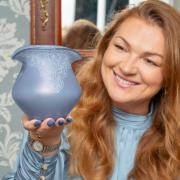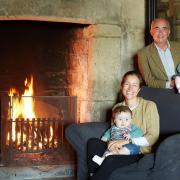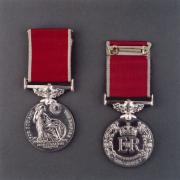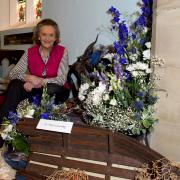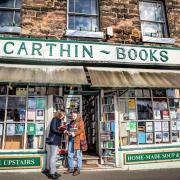Born in 1875 in Arnold, Nottinghamshire, Arthur Hammond (he later added Knighton to his name) developed an early interest in art.
This was fuelled by the local artists - Jack Birkin, William Stanley, Thomas Cooper Moore and his son amongst others – who not only sold their work in the Hammond family shop but also regularly joined the family for Sunday lunch.
One can imagine the influence of such eminent artists upon Arthur’s budding talent.
Leaving school at the age of eleven, Arthur was employed locally and signed up for evening classes at Nottingham School of Art studying under Herbert Wilson Foster (1846-1929).

The two-hour classes started at 7.30pm, making for long days that ended with a five mile walk home. But Arthur was a dedicated student and graduated with good grades.
Arthur’s summer vacation in 1890 was a painting expedition to some of Derbyshire’s renowned beauty spots: Haddon Hall, the Derwent Valley and Lathkil Dale.
Travelling by train, he lodged near Rowsley railway station. Haddon Hall, with its spacious and sunny Artist’s Room equipped with sketching easels and stools, was a major attraction.
It was there that Arthur met several professional artists prepared to guide and advise him, including the accomplished watercolourist Ernest Arthur Rowe.
Arthur recalled how one day, whilst painting outdoors, he was distracted by an elderly gentleman dressed in Harris tweed and a Glengarry bonnet dozing on a garden seat under a yew hedge.

Discovering later that this was Lord John Manners, Duke of Rutland, Arthur regretted not having seized the opportunity to paint the aristocratic gentleman’s portrait.
Extending his holiday, Arthur ventured further afield to Edensor near Chatsworth House but, after two weeks, was then obliged to return to his day job.
His diary records how his dislike for this job was so great that, aided and abetted by his local doctor William Lamb, an early fan of Arthur’s paintings, he regularly feigned illness ‘to go in the fields sketching or surreptitiously take a few days off and go to Haddon Hall’.
In July 1894 Arthur accompanied two fellow artists, Jack Bowman and Sydney Gardner, on a day excursion to Haddon Hall.
Walking the two miles from Rowsley station through the Lathkil and Alport Dales they were all so charmed by the scenery that they quickly decided to return to the area and so took lodgings at a farmhouse on Stanton Hill for six weeks.
Whilst there, Arthur recalled how one day, working alone in a tapestry-hung room, he was joined by a lady dressed head to toe in black who began sketching an impressive oriel window in the room.

Whilst conversing, Arthur thought her charming though somewhat sad and troubled. He later discovered her to be Violet, Marchioness of Granby, and that her nine-year-old son, Lord Haddon, had died a few days earlier.
The Marchioness was herself an accomplished artist and Arthur would later become better acquainted with her and her family.
In 1900 Arthur moved to London intending to make his living as an artist but he may well have got homesick after five years as he returned to the Midlands where he rented a house with a studio in Youlgreave.
This was a productive time for him. In addition to his paintings, he published postcards based on his original etchings of Haddon Hall and its surroundings.
Haddon Hall and the Derbyshire Dales continued to inspire his work be it the waterfalls, waterwheels, bridges or the vernacular buildings all of which he painted in a style reminiscent of the Romantic landscape paintings of the previous century.
Soon after his return he held an exhibition of his work at Bakewell Town Hall, which was much heralded by the Derbyshire Times:
‘Mr Arthur H Hammond, an artist whose work has attracted a good deal of appreciative attention locally, since he made his home at Youlgreave, is holding an exhibition… a new departure for the district, and Mr Hammond’s enterprise should attract the interest of art lovers in the neighbourhood.”

The artist achieved another milestone in 1907 when his painting - Golden Autumn, Derbyshire – was accepted for exhibition by the Royal Academy.
The following year a second painting - An Autumn Afternoon, Lathkil Dale, Derbyshire – was also accepted and attained the distinction of being hung on the line (the line of pictures hung at eye level was considered by the hanging committee to be the most important).
These paintings highlighted the artist’s keen appreciation of and ability to capture in paint the local landscape with its ever-changing skies, seasonal moods and shifting light.
Arthur Hammond left Derbyshire in late 1908, moving initially to Colwyn Bay in North Wales before settling in the Manchester area. In 1920 he travelled to America on a six-month commission before spending a decade in Continental Europe. His later years were spent in Somerset and Dorset.
Since his death in 1970, at the great age of 94, his extraordinary life has largely been overlooked, apart from his biography by Peter Norris in 1994 and until recently, with the first large scale exhibition at David Messum Fine Art in London’s, St James’s.
Interest in the show demonstrated the enduring attraction of Knighton-Hammond’s work to current audiences and a selection of these paintings and the exhibition catalogue are still available for sale at: messums.com/exhibitions/view/820.
For more information visit knighton-hammond.com. Arthur Henry Knighton-Hammond by Peter Norris, was published by Lutterworth Press, Cambridge, 1994.








